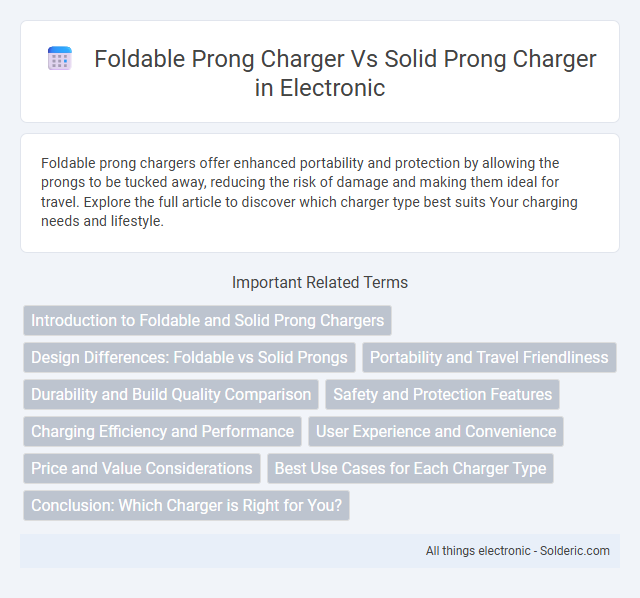Foldable prong chargers offer enhanced portability and protection by allowing the prongs to be tucked away, reducing the risk of damage and making them ideal for travel. Explore the full article to discover which charger type best suits Your charging needs and lifestyle.
Comparison Table
| Feature | Foldable Prong Charger | Solid Prong Charger |
|---|---|---|
| Design | Prongs fold into the charger body for compactness | Fixed, non-foldable prongs |
| Portability | Highly portable due to foldable prongs | Less portable; prongs protrude and risk damage |
| Durability | Prongs can wear out with frequent folding | More durable due to solid construction |
| Storage Safety | Safe to store with other items; prongs protected | Risk of prong damage or snagging other items |
| Aesthetic | Sleek and modern look | Classic, traditional appearance |
| Price | Generally more expensive due to complex design | Usually cheaper and simpler |
Introduction to Foldable and Solid Prong Chargers
Foldable prong chargers feature retractable pins that can be tucked inside the charger body, enhancing portability and reducing the risk of damage during travel. Solid prong chargers have fixed pins that provide a sturdier connection but are bulkier and less convenient to carry in tight spaces. Both types serve the essential function of charging electronic devices, with foldable models favored for mobility and solid prong chargers valued for durability.
Design Differences: Foldable vs Solid Prongs
Foldable prong chargers feature retractable metal prongs that fold into the charger body, enhancing portability and reducing the risk of damage or snagging during transport. Solid prong chargers have fixed, non-retractable prongs that offer a sturdier connection but can be bulkier and less convenient for travel. The foldable design prioritizes compactness and protection, while solid prongs emphasize durability and straightforward plug-in functionality.
Portability and Travel Friendliness
Foldable prong chargers offer enhanced portability by allowing the prongs to retract into the charger body, reducing the risk of damage and making them compact for easy storage in bags or pockets. Solid prong chargers, while sturdy, protrude permanently and can snag or cause scratches during travel, making them less convenient for frequent travelers. The foldable design optimizes space-saving and prevents accidental prong bending, significantly improving travel friendliness compared to solid prong chargers.
Durability and Build Quality Comparison
Foldable prong chargers offer enhanced portability and protection by shielding the prongs when not in use, reducing wear and tear compared to solid prong chargers that have exposed metal contacts prone to bending or breaking. Solid prong chargers generally feature a more rigid build, which may provide greater structural strength but can be more susceptible to damage during transport. Your choice between the two impacts long-term durability, with foldable designs often favored for their ability to maintain prong integrity over time.
Safety and Protection Features
Foldable prong chargers offer enhanced safety by reducing exposure to prongs when not in use, minimizing the risk of accidental electric shocks and damage during transport. Solid prong chargers, while sturdy, lack retractable features, increasing vulnerability to prong bending and accidental contact, which can lead to short circuits or injury. Many foldable models incorporate built-in surge protection and temperature control technologies, providing superior protection against electrical hazards compared to traditional solid prong chargers.
Charging Efficiency and Performance
Foldable prong chargers offer comparable charging efficiency to solid prong chargers, often featuring advanced circuitry that ensures stable power delivery and protects your devices from overheating or overcharging. Solid prong chargers provide robust performance with a durable design that maintains consistent contact and minimal resistance, which can translate into reliable charging speeds. Your choice depends on whether you prioritize portability or the traditional durability of a solid prong design without sacrificing charging efficiency.
User Experience and Convenience
Foldable prong chargers enhance user experience by offering compactness and ease of portability, reducing the risk of prong damage and snagging in bags. Solid prong chargers provide a durable and sturdy connection but can be bulkier and less convenient for travel. Users prioritize foldable prong chargers for their space-saving design and improved safety during transport.
Price and Value Considerations
Foldable prong chargers typically offer greater portability and protection for your charger prongs, often priced slightly higher than solid prong chargers due to their convenience features. Solid prong chargers, while usually more affordable, provide durable and reliable charging without the added flexibility of folding mechanisms. Your choice depends on whether you prioritize budget-friendly durability or enhanced portability and compact storage.
Best Use Cases for Each Charger Type
Foldable prong chargers are ideal for frequent travelers and commuters who prioritize portability and compact storage, minimizing the risk of damage in bags or pockets. Solid prong chargers perform best in stationary settings like offices or homes where durability and consistent connection stability are paramount. Choosing the right charger depends on your lifestyle needs, balancing convenience with long-term reliability.
Conclusion: Which Charger is Right for You?
Foldable prong chargers offer enhanced portability and space-saving features, making them ideal for frequent travelers or those with limited storage space. Solid prong chargers provide durability and stability, often preferred for everyday use or environments where the charger remains stationary. Your choice depends on balancing convenience with robustness based on your lifestyle and usage needs.
Foldable prong charger vs solid prong charger Infographic

 solderic.com
solderic.com